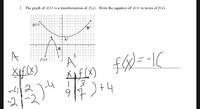You are using an out of date browser. It may not display this or other websites correctly.
You should upgrade or use an alternative browser.
You should upgrade or use an alternative browser.
How to find the a, b, c and d values?
- Thread starter MARTY122
- Start date
Dr.Peterson
Elite Member
- Joined
- Nov 12, 2017
- Messages
- 16,873
What do you mean by a, b, c, and d? I think you are assuming we know what form of equation you are trying to write. Maybe it's g(x) = af(bx + c) + d, or maybe it's something else.
I would start by listing transformations, not numbers.
If, for example, your "a" is the vertical multiplier, then it performs a vertical stretch and reflection. Please tell us your thinking in those terms, and give your reasons. (If I'm right, a is negative, but not -1.)
I would start by listing transformations, not numbers.
If, for example, your "a" is the vertical multiplier, then it performs a vertical stretch and reflection. Please tell us your thinking in those terms, and give your reasons. (If I'm right, a is negative, but not -1.)
Yes that is the equation I was going for. I’m sorry, I still don’t understand.What do you mean by a, b, c, and d? I think you are assuming we know what form of equation you are trying to write. Maybe it's g(x) = af(bx + c) + d, or maybe it's something else.
I would start by listing transformations, not numbers.
If, for example, your "a" is the vertical multiplier, then it performs a vertical stretch and reflection. Please tell us your thinking in those terms, and give your reasons. (If I'm right, a is negative, but not -1.)
Dr.Peterson
Elite Member
- Joined
- Nov 12, 2017
- Messages
- 16,873
The way to get help is not to just say "I don't understand", but rather "Here is what I understand, and here is what I don't". You've given me no new information.
Clearly you have learned something about transformations; please tell me what you see in these graphs, in terms of transformations. For example (picking numbers at random), you might find that the graph of f is stretched horizontally by a factor of 3 and reflected over the x-axis, then translated (shifted) 2 units to the right and 3 up, to create the graph of g.
Here is something I wrote about this sort of problem, that may help: Finding Transformations from a Graph
That problem is a little simpler than yours, as one of the graphs is for a "basic" function; but it's not very different. Since yours is a relatively challenging type, it may be that we should work on an easier problem that you were given before we tackle the hard one. If you want to do that, maybe you can pick the first problem in a set that you have trouble with.
Clearly you have learned something about transformations; please tell me what you see in these graphs, in terms of transformations. For example (picking numbers at random), you might find that the graph of f is stretched horizontally by a factor of 3 and reflected over the x-axis, then translated (shifted) 2 units to the right and 3 up, to create the graph of g.
Here is something I wrote about this sort of problem, that may help: Finding Transformations from a Graph
That problem is a little simpler than yours, as one of the graphs is for a "basic" function; but it's not very different. Since yours is a relatively challenging type, it may be that we should work on an easier problem that you were given before we tackle the hard one. If you want to do that, maybe you can pick the first problem in a set that you have trouble with.
Steven G
Elite Member
- Joined
- Dec 30, 2014
- Messages
- 14,603
What is the vertex of f(x) and what is the vertex of g(x)? In words, how do you go from the vertex of f(x) to the vertex of g(x) (how many spaces, if any do you go to the right or left and same for up and down)? How can this help you?
Personally I would use the form g(x) = af(b(x-c)) + d. Then I would distribute the b
Personally I would use the form g(x) = af(b(x-c)) + d. Then I would distribute the b

